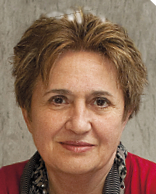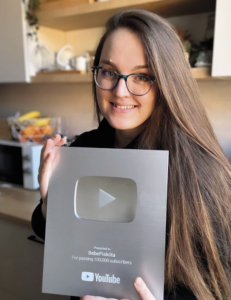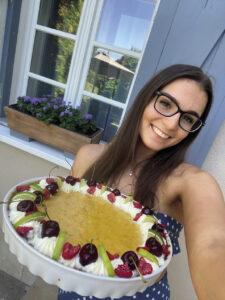What strategies do gastro-influencers follow?

Dr. Mária Törőcsik
professor
University of Pécs

Míra Mohr
gastro rockstar
Süti MáMohr
Dr Mária Törőcsik, a professor at the University of Pécs and Míra Mohr, an economist behind the Süti MáMohr blog and self-proclaimed gastro rock star, did a qualitative survey on the market attitudes of Hungarian online opinion leaders. They made 11 in-depth interviews with key players in the market of gastro-communication. For instance one of the bloggers shares recipes on YouTube, and we can know another from the television screen. There is one who has lots of followers on Instagram and TikTok, and one of the influencers is a gastro-blogger. Two from the 11 interviewees live off being bloggers, so they don’t have another job. Four of them are entrepreneurs in the sector, this is their main job, but they also work for others – not only on their own platforms. Five of them have a job in other sectors, they are active in gastro-communication in their free time.
Mirtill Bodolai:
“I think one has to realise what kind of people they would like to reach with their content. It took me a while to find my audience, but I found out that many people – just like me – love retro recipes, the one’s our parents cooked from when we were little.”
Digitalisation, innovations
The algorithms used by Instagram have been designed to give users the most optimal experience, so much so that there is no Jolly Joker strategy for being successful on this platform. It is very difficult to reach the target audience, but sometimes it is also very easy – this unpredictability causes the biggest problem for professional account holders. Three of the interviewees said the appearance of TikTok and the proliferation of short-form videos have resulted in quality deterioration. Six of the influencers opined the market is seasonal: autumn and winter are the peak periods and there is a decline in summer and winter.
Beáta Nagy-Pojdin:
“There is always a weaker period in the summer, and I think this is because people like to be outside and they travel in the summer. The beginning of the year is also very difficult, after the holidays. Then from March things get better and better as Easter is approaching.”
Gréta Kapunics:
“My observation is that my audience is the least active in spring and summer. (…) In the autumn people like to stay at home and bake cakes very much, and of course there is Christmas, when my reach is rising linearly.”
Communication
In the saturated market of the food industry, it isn’t enough to tell consumers that the given product is really tasty. Advertisers are focusing more and more on emotions instead of communicating taste.
Zsófia Böröcz:
“Education is my main mission, because I am not a showwoman. I do understand how and why things are happening in the media, but I can’t identify with these things. For me communication is first and foremost about education.”
Two gastro-influencers mentioned entertainment, and another two said they simply tell the name of the cake and the recipe – they don’t add colour to their communication with any attributes. The survey has found no relationship between the number of followers and the type of communication used.
Word-of-mouth advertising in online communities
When we are talking about the spreading of information in the digital space, we must analyse the effect of word-of-mouth advertising in the online community (e-WOM). In accepting this e-WOM, it is crucial to see how close the relationship is between the members of the network, and how similar they feel they are to the influencer.
Mirtill Bodolai:
“Monitoring what fellow bloggers are doing, what I see is that their life situation determines what kind of people follow them – in most cases it is people who are in a similar situation.”
Funnily enough two interviewees said their competitive edge is that they are exactly like any other person. They have used a bottom-up approach to build themselves, learning to bake together with their followers.
Gréta Kapunics:
“I explain recipes in a fashion that is easy to understand for everyone. (…) I am not a French pastry chef, so both beginners and advanced level housewives can work with the recipes I share.”
Web analytics and knowing the target audience
One of the best things about operating online is that one can get market information without having to pay for it. Measurable data is available to influencers, which can be analysed. Somewhat surprisingly the 11 gastro-influencers don’t really use this opportunity. Some said they are afraid that the results of web analytics will have a negative influence on their spontaneity. Most of the influencers have an idea about who their followers are, and they can also characterise them to a certain extent, but not so much that they can be put into categories. Two of them have in-depth knowledge of their follower base, and they could also name segments in this group (one has acquired this knowledge herself, while the other has commissioned an agency with this) – both of them do this as a full-time job.
Beáta Nagy-Pojdin:
“I have lots of mothers who follow me not because they are baking cakes too, but because they find it inspirational that a young mother does something like this and she is successful. People like to see success stories.”
Conclusion
We can conclude that the two full-time bloggers manage their activities more professionally, and it seems that that they are making great efforts not only to preserve their competitive advantage, but also to make it bigger. Having a large number of followers isn’t a prerequisite of working in this field full-time, but in this case the influencer must also do other things than just blogging, e.g. photography, marketing, etc. However, having many followers is essential for being a full-time blogger and living off one’s own platform only. The majority of the interviewees think that innovative nature of the market is generated by the supply side, and those who are active in this field should calculate with the weaker periods (summer, beginning of the year) when planning their marketing strategies. //
Bebepiskóta

Beáta Nagy-Pojdin
Mirtill Bodolai graduated as an English major from the University of Miskolc, and currently she works in the IT sector. For her baking is a hobby, and her Mentesen Édesebb Instagram page has more than 60,000 followers; across various platforms she has 68,000 followers. //
Gasztromentor

Zsófi Böröcz
Zsófi Böröcz was the winner of the 2018 season of the RTL television show Konyhafőnök. She graduated from BGE in 2008, and with 5 years of managerial experience she moved to London, where she worked in Gordon Ramsey’s restaurant, Maze Grill. She has 4,500 followers.//
Mentesen Édesebb

Mirtill Bodolai
Mirtill Bodolai graduated as an English major from the University of Miskolc, and currently she works in the IT sector. For her baking is a hobby, and her Mentesen Édesebb Instagram page has more than 60,000 followers; across various platforms she has 68,000 followers. //
Édes Semmittevés

Gréta Kapunics
Gréta Kapunics is a 26 years old, and she earned a degree in tourism and hospitality at BGE. She works as a social media manger, and she started blogging about 8 years ago.
She has 86,000 followers on various social media platforms. //
This article is available for reading in Trade magazin 2023/4.
Related news
KPMG CEO Outlook 2025: replanned trust
🎧 Hallgasd a cikket: Lejátszás Szünet Folytatás Leállítás Nyelv: Auto…
Read more >Style, language and tools
🎧 Hallgasd a cikket: Lejátszás Szünet Folytatás Leállítás Nyelv: Auto…
Read more >Generations X and Y would be happy to cook more
🎧 Hallgasd a cikket: Lejátszás Szünet Folytatás Leállítás Nyelv: Auto…
Read more >Related news
More convenient payment options and new features are coming to BudapestGO
🎧 Hallgasd a cikket: Lejátszás Szünet Folytatás Leállítás Nyelv: Auto…
Read more >Skiers can expect an average travel insurance premium of around 870 forints per day this season.
🎧 Hallgasd a cikket: Lejátszás Szünet Folytatás Leállítás Nyelv: Auto…
Read more >(HU) Elegáns és egyszerű vendégváró falat az ünnepi asztalra – A nap videója
🎧 Hallgasd a cikket: Lejátszás Szünet Folytatás Leállítás Nyelv: Auto…
Read more >






